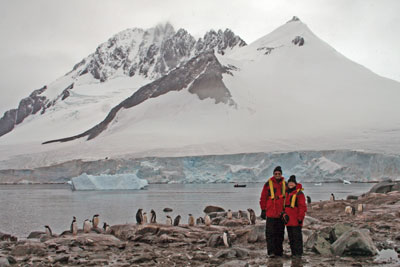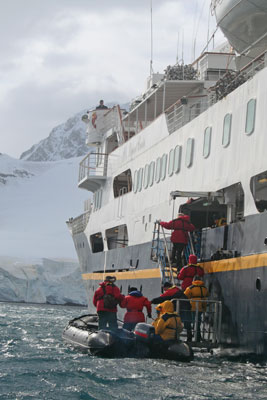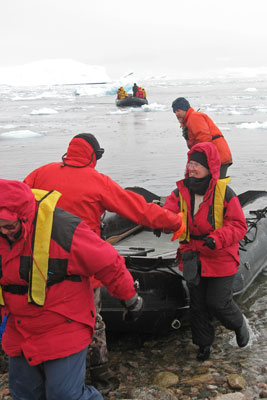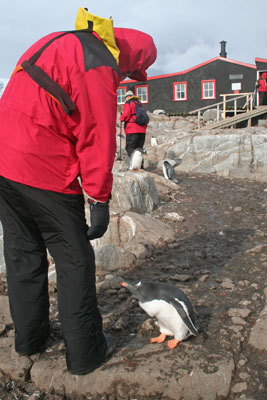‘Antarctica’s White Wilderness’
Lively discussions on the ITN Message Board and subsequent research enticed my husband and me to book the memorable trip “Antarctica’s White Wilderness,” Feb. 28-March 13, 2008, with Overseas Adventure Travel (North Cambridge, MA, 800/955-1925, www.oattravel.com). The base cost, air included from Orlando, was $6,495 per person.
Our trip began in a panic. When we presented our e-tickets at the Orlando airport, the Delta agent said, “Your reservation was canceled. No one paid for the tickets, so we gave away the seats. The flight is full.”
During the next half hour, the agent, working on our behalf with OAT air staff, managed to get us rerouted through Miami onto LAN Argentina in business class. Lesson learned — always reconfirm e-tickets with the airline yourself; do not depend on the travel company to do it.
LAN Argentina is a superb airline, and the business-class seats reclined 180 degrees.
We met our group of 30 in Buenos Aires, Argentina. Our hotel, 725 Buenos Aires (Av. Roque Saenz Pena 725; www.725continental.com), was centrally located and comfortable, with a helpful staff.
As we explored the city, we discovered the charm and history of the Argentine culture. One relaxing highlight was hot chocolate with churros at Gran Café Tortoni (825 Av de Mayo; www.cafetortoni.com.ar), perhaps the oldest café in Buenos Aires. This elegant café boasted Tiffany glass ceilings, tuxedo-clad waiters and a rich ambience.
We continued to Ushuaia, the world’s southernmost city, and after a tour of scenic Tierra del Fuego National Park we boarded the M/S Andrea, which would be our home in the Antarctic.
The Andrea, a 286-foot ice vessel specially designed for remote exploration, far exceeded our expectations. It held 105 passengers, but on this OAT charter there were only 90.
Our category-2 cabin (No. 603) was opulent compared to my expectations. Onboard amenities included a restaurant, combination lounge/lecture facility, forward-viewing observation deck and a small library. The chef and all crewmembers were superb.
To reach the Antarctic and return, ships must traverse the infamous Drake Passage, where the warmer Atlantic and Pacific oceans meet the colder Southern Ocean. We were warned that if the seas were too rough on either of the 2-day crossings, we might be restricted to our cabins.
Luckily, the trip south was very smooth, which meant we could even go outside on deck to watch the albatrosses. Our trip back proved rougher. The captain saw a huge storm coming and rushed our last landing to outrun the storm. This passage was average in roughness, with 14-foot swells, and we were not permitted on deck. Our bed had sideboards, bolster pillows and even a “bed belt” to prevent us from falling out!
During the crossings and nearly every day, our expedition team, specialists in marine biology, glaciology and polar history, gave talks explaining what we were seeing. For example, we learned (with fossils of ferns and dinosaurs) how Antarctica was once warm; how whalers nearly decimated the whale population for their oil, and about the early expeditions. Most alarming was the talk about global warming.
Before booking the trip, we were warned that “when nature and elements permit, we’ll make wet landings via inflatable Zodiac boats.” Our weather was a balmy 40°F most days, with occasional rain or fog. We managed 10 landings!
For the wet landings, we simply scooted as close to land as possible, then swung our legs over the side of the Zodiac and waded ashore. The deepest water was about 14 inches and it was not slippery.
Regulations permit no more than 100 people ashore at a time. Since our ship was so small, all passengers who wanted to could go ashore. We usually stayed ashore several hours, with options of hiking with the expedition team or simply sitting on shore watching the penguins play. Since it was so late in the season, instead of seeing eggs or babies we enjoyed the curious “teenagers” frolicking and learning to swim.
I took more photos than anticipated and needed two different adapters for my battery charger: one for Argentina plus a European 2-pin adapter while aboard ship. I usually kept my camera tucked inside my parka when not using it, and I always carried extra batteries in a dry pocket.
Keeping horizons flat when photographing from a rocking boat and compensating for so much blue proved my biggest photographic challenges.
The glaciers and icebergs in the Antarctic made those in Alaska seem small. We saw the damage done by man to this pristine environment. We saw fossils from prehistoric times, abandoned whalers’ blubber cookers, penguins, birds, whales, seals, fragile tundra greenery and more.
A common query I hear is, “Would you recommend the trip?” Even with post-season discounts, this is an expensive adventure with no guarantees. We could have had weather so difficult, we would not have been able to go ashore. We could have arrived too late to see the penguins and other wildlife. Each expedition is different. We were very fortunate with transit, accommodations, landings and sightings.
In the end, with 30-plus years of international travel, I rank “Antarctica’s White Wilderness” among my top five trips!
WANDA BAHDE
Summerfield, FL




